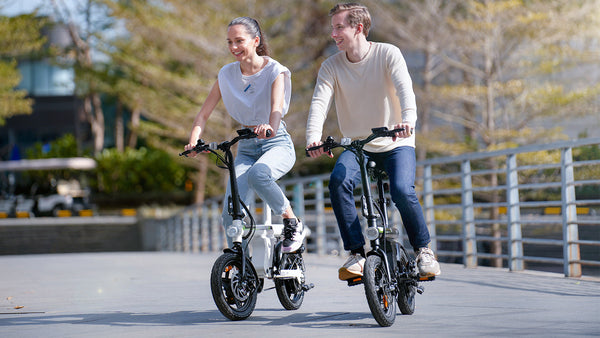
How to Reset Your Electric Bike Battery – Simple Methods to Fix Common Issues
Your electric bike battery is the powerhouse that keeps your rides smooth and enjoyable. But like any piece of technology, it can sometimes act up—whether it’s showing incorrect charge levels, draining too quickly, or flashing confusing error codes. The good news? In many cases, a simple reset is all it takes to get things back on track. Learning how to reset an electric bike battery can save you from unnecessary stress, costly repairs, or even buying a replacement too soon. In this guide, we’ll walk you through six easy methods to reset your e-bike battery, along with practical tips to keep it performing at its best.
Why Resetting Your Electric Bike Battery Improves Performance and Lifespan
Resetting your electric bike battery may sound like a small step, but it can make a big difference in how your e-bike performs. Here are the main reasons why a reset is worth trying before replacing your battery:
Calibration for Accurate Charge Readings
Over time, your battery’s charge indicator can become inaccurate, showing full when it’s not or dropping suddenly during a ride. Resetting helps recalibrate the battery management system (BMS), ensuring that the display shows the true charge level. This gives you a more reliable idea of how far you can ride before needing to recharge.
Fixing Battery Management System (BMS) Errors
The BMS is the “brain” of your e-bike battery, regulating charging, discharging, and overall safety. Like any software-driven system, it can sometimes glitch. A reset clears minor errors and allows the BMS to restart fresh, often solving issues such as unexpected cutoffs or error codes on your display.
Improving Battery Performance and Range
If your battery feels weaker than it used to—delivering less power or running out of juice too quickly—a reset may help. By recalibrating the internal systems, the battery can distribute energy more efficiently, improving both performance and riding range.
Extending Overall Battery Lifespan
Frequent resets are not always necessary, but doing one when issues arise can reduce stress on the battery cells and electronics. This preventive step helps keep the battery healthy longer, meaning you won’t need a costly replacement as soon.
How to Reset an Electric Bike Battery – Simple Methods
Reset an E-Bike Battery with the Disconnect Method
If your e-bike doesn’t have a reset option on the display, you can perform a manual reset by disconnecting the battery. This clears residual power from the electronics and forces the system to restart.
How to do it:
-
Power off the bike completely.
-
Remove the battery carefully from its compartment.
-
Leave it disconnected for 5–10 minutes.
-
Reinsert the battery and make sure it’s securely in place.
-
Turn the bike back on.
Benefits of this method:
This reset works well when your e-bike feels “stuck” or unresponsive, giving the system a clean reboot.
Manual E-Bike Battery Reset Using the Built-In Button
Some e-bike batteries, especially on certain models, include a built-in reset button on the battery pack itself.
How to do it:
-
Locate the reset button (check your manual if unsure).
-
Press and hold it for 10–20 seconds.
-
Release the button and wait briefly before restarting the bike.
When to use it:
This is a fast and effective method when you need to clear more persistent issues without removing the battery.
Soft Reset an Electric Bike Battery via the Display Console
Many modern e-bikes come with a built-in reset feature accessible through the display console. This option recalibrates the battery without removing it, making it one of the easiest fixes.
How to do it:
-
Turn off your e-bike completely.
-
Power it back on and navigate to the display settings.
-
Look for a reset or factory reset option.
-
Follow the on-screen prompts to confirm.
-
Restart your bike once the reset is complete.
When to use it:
A soft reset is ideal if your e-bike shows inaccurate charge readings or minor error codes. It essentially tells the battery management system (BMS) to “start fresh.”
Recalibrate an Electric Bike Battery with a Full Discharge and Recharge Cycle
A full discharge and recharge cycle can recalibrate your battery if it’s showing inaccurate charge levels or cutting out unexpectedly.
How to do it:
-
Ride your bike until the battery is completely drained.
-
Once empty, plug it in and fully recharge without interruptions.
-
Test the bike after charging to see if performance has improved.
When to repeat it:
You may need to perform this cycle a couple of times for best results. It’s especially useful if your range has decreased or the display is inconsistent.
Reset and Diagnose an E-Bike Battery Using Diagnostic Tools
Some e-bike manufacturers provide diagnostic tools that can plug into the bike or battery system. These are designed to troubleshoot deeper issues and may even update the firmware.
What they can do:
-
Reset the BMS
-
Run error diagnostics
-
Update software for improved performance
When to use it:
Diagnostic tools are most commonly used at bike shops or repair centers, but some manufacturers allow riders to purchase or access them directly. They’re best for stubborn issues that other resets can’t fix.
Advanced Method – Resetting the E-Bike Battery Management System (BMS) Internally
The BMS is the control unit inside your battery that manages charging, discharging, and safety. If basic resets don’t work, an internal reset may be necessary—but this is an advanced method.
How to do it:
-
Carefully open the battery casing (only if you’re confident and aware it may void the warranty).
-
Locate the BMS wiring harness.
-
Disconnect it briefly, then reconnect while charging.
-
Reassemble the battery and restart your bike.
Safety note:
This method should only be attempted if you’re comfortable working with electronics. Otherwise, it’s safer to let a professional handle it.
How to Check Performance After Resetting Your Electric Bike Battery
Once you’ve performed a reset, it’s important to check whether the issue has been resolved. A reset helps the battery management system (BMS) recalibrate, but confirming the results ensures your e-bike is safe and ready for regular use.
Test the Battery Charge and Performance
After resetting, plug in your charger and allow the battery to reach a full charge. Pay attention to whether the charging process feels normal and whether the display shows an accurate percentage. A stable charge reading is a good sign that the reset worked.
Do a Short Ride to Check Responsiveness and Range
Take your e-bike for a short test ride in a safe area. Monitor how the motor responds to pedaling, how smoothly the power delivers, and whether the battery holds its charge as expected. If the range feels closer to normal, your reset likely solved the issue.
Steps if Issues Persist
If the problems continue—such as the battery draining too quickly, showing error codes, or cutting out—you may need to repeat the reset. For persistent issues, it’s best to contact your e-bike manufacturer or a certified repair shop. They can run diagnostics, update firmware, or confirm if a replacement battery is necessary.
How Updating Your Electric Bike Battery Firmware Improves Performance
Keeping your e-bike’s firmware updated is an often-overlooked way to improve battery health and overall performance. Manufacturers regularly release software updates that fine-tune how the battery management system (BMS) works, helping your bike run more efficiently.
Why Keeping Firmware Updated Helps
Firmware acts like the operating system for your e-bike’s electronics. By updating it, you ensure your battery communicates correctly with the motor, charger, and display. This reduces the chance of errors and keeps your e-bike running smoothly.
How Updates Can Fix Bugs and Improve Performance
Outdated firmware can cause issues such as inaccurate charge readings, unexpected cutouts, or reduced efficiency. A simple update can resolve these problems, extend range, and even unlock performance improvements added by the manufacturer. Always check your e-bike brand’s website or app for the latest updates and follow their instructions to install them safely.
How to Maintain Your Electric Bike Battery for Best Performance
Resetting your battery can solve immediate problems, but long-term care is just as important for keeping your e-bike battery reliable and extending its lifespan. Follow these essential maintenance tips to avoid common issues and maximize performance.
Avoid Deep Discharges (Keep Above 30–40%)
Letting your battery drain completely on a regular basis can stress the cells and shorten its life. Instead, try to recharge when the level drops to around 30–40%. Keeping it within this range reduces wear and helps maintain a consistent riding range.
Store in a Cool, Dry Place
Heat is one of the biggest enemies of lithium-ion batteries. Always store your e-bike battery in a cool, dry environment away from direct sunlight or damp areas. Avoid leaving it inside a hot car or exposed to freezing temperatures for long periods.
Inspect for Physical Damage
Regularly check the battery casing, connectors, and charging port for any signs of wear or damage. Cracks, dents, or corrosion can affect performance and even pose safety risks. Cleaning the contacts gently with a dry cloth can also help maintain a good connection.
Partial Charge (30–60%) for Long-Term Storage
If you won’t be riding your e-bike for weeks or months, don’t store the battery at 0% or 100%. Instead, keep it partially charged at around 30–60%. This storage level helps preserve battery health and prevents long-term cell degradation.
Additional Electric Bike Battery Maintenance Advice
Beyond resets and routine maintenance, a few extra practices can go a long way in protecting your e-bike battery. These habits not only prevent common issues but also help ensure consistent performance over time.
Correct Storage Practices
When storing your e-bike for weeks or months, keep the battery partially charged (30–60%) and remove it from the bike if possible. Store it in a dry, cool location away from moisture or direct sunlight. Proper storage helps prevent cell degradation and extends battery life.
Avoiding Extreme Temperatures
Both hot and cold temperatures can harm your electric bike battery. Avoid charging or riding in freezing conditions, and never leave your battery in a hot car or exposed to direct sun for long periods. Extreme heat can permanently damage the cells, while freezing can reduce efficiency.
Importance of Firmware Updates
Firmware updates from your e-bike manufacturer often include fixes that improve charging efficiency, range accuracy, and safety. Keeping your firmware current ensures your battery management system (BMS) operates correctly and minimizes the chance of recurring errors.
Using Manufacturer-Recommended Chargers
Always use the charger supplied by or recommended for your e-bike battery. Third-party or mismatched chargers can damage the cells, overheat the battery, or reduce its long-term capacity. Sticking with the manufacturer’s charger ensures safe, efficient charging every time.
Conclusion – Resetting Your Electric Bike Battery the Right Way
Resetting your electric bike battery is a practical solution for many common issues, from inaccurate charge readings to reduced performance or sudden cutouts. Depending on the situation, you can choose from several reset methods, starting with simple options like a soft reset or battery disconnect, and moving to more advanced techniques such as a full discharge cycle, BMS reset, or diagnostic tools. Alongside resets, regular maintenance practices—like avoiding deep discharges, storing your battery in a cool place, and keeping firmware updated—are key to ensuring long-lasting performance. Always try the simpler methods first, and if problems persist, don’t hesitate to contact your manufacturer or a professional repair service for support.
FAQs
Where is the reset button on an e-bike?
The reset button on an e-bike is usually located on the battery pack itself, though its exact position can vary depending on the brand and model. On some bikes, it may be a small recessed button you need to press with a pin or tool, while others have a clearly visible button near the battery indicator lights. Always check your user manual for the exact location, as pressing and holding the reset button is often the quickest way to resolve minor battery or system issues.
Why is my e-bike battery suddenly not working?
If your e-bike battery suddenly stops working, it could be due to a few common issues. The battery may be fully discharged, the connections might be loose or dirty, or the Battery Management System (BMS) may have shut it down to protect against overcharging, overheating, or short circuits. In some cases, the problem could also be with the charger or wiring rather than the battery itself. A simple reset, cleaning the contacts, or checking the charger often solves the issue, but if the problem persists, professional inspection may be needed.
How do I know if my e-bike battery fuse is blown?
You can usually tell if your e-bike battery fuse is blown when the bike won’t power on, even though the battery is fully charged. In some cases, you might also notice the battery not charging at all. To confirm, remove the battery and check the fuse—most are located inside the battery pack or near the terminals. A blown fuse will often look darkened, broken, or have a melted wire inside the glass tube. If you’re unsure, use a multimeter to test for continuity. Replacing a blown fuse is usually a quick fix, but always use the correct type recommended by your manufacturer.
What is the common problem of e-bike?
One of the most common problems with e-bikes is battery-related issues, such as reduced range, incorrect charge readings, or the bike not turning on. Other frequent concerns include motor cutouts, faulty wiring connections, or display errors that affect performance. Many of these problems can often be solved with simple fixes like resetting the battery, checking connections, or updating the firmware. Regular maintenance and proper battery care help prevent most of these issues and keep your e-bike running smoothly.
Product Category
Recent Posts

Best Long-Range Electric Bikes in the UK – Go Further with E‑Bikes from iHoverboard

Best Ladies Electric Bike: Top iHoverboard Models Under £1000

How to Reset Your Electric Bike Battery – Simple Methods to Fix Common Issues

How Much Does It Cost to Charge an Electric Bike in the UK? Real Costs, Savings & Tips



























































Still, need help? Contact Us: support@ihoverboard.com
What's the option? Check out the option now!
Leave us a message